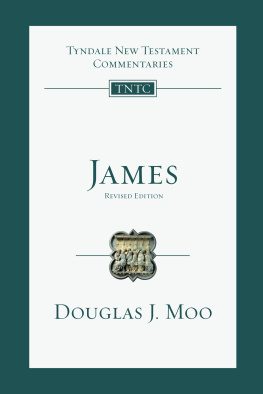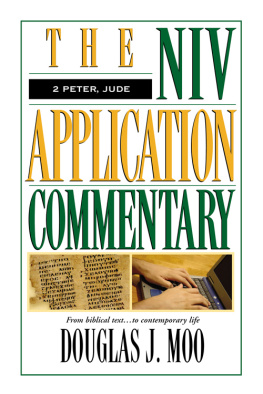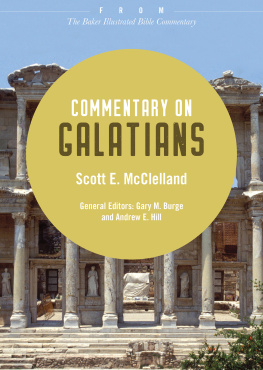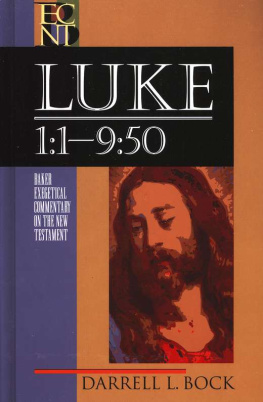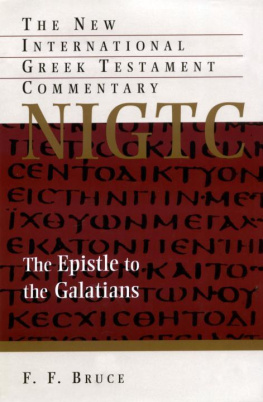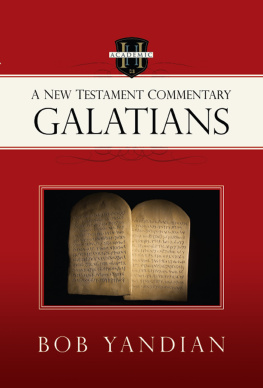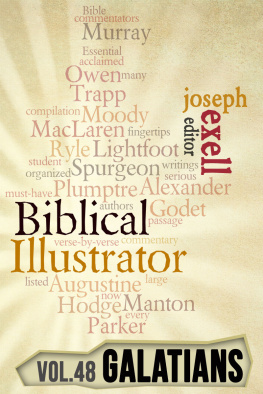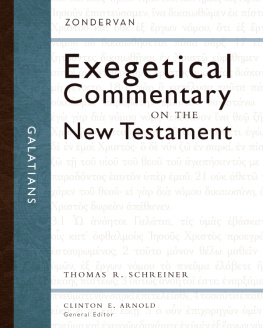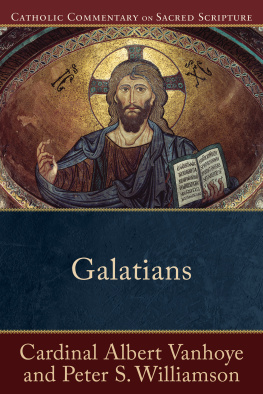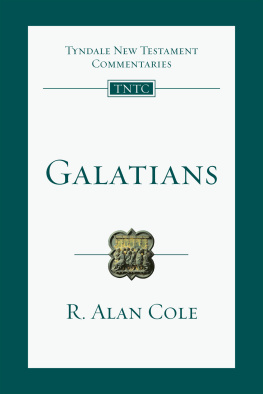Baker Exegetical Commentary on the New Testament
ROBERT W. YARBROUGH
AND ROBERT H. STEIN, EDITORS
Volumes now available
| Matthew | David L. Turner |
| Mark | Robert H. Stein |
| Luke | Darrell L. Bock |
| John | Andreas J. Kstenberger |
| Acts | Darrell L. Bock |
| Romans | Thomas R. Schreiner |
| 1 Corinthians | David E. Garland
|
| 2 Corinthians | George H. Guthrie
|
| Galatians | Douglas J. Moo |
| Ephesians | Frank Thielman |
| Philippians | Moiss Silva |
| 12 Thessalonians | Jeffrey A. D. Weima |
| James | Dan G. McCartney |
| 1 Peter | Karen H. Jobes |
| 13 John | Robert W. Yarbrough |
| Jude and 2 Peter | Gene L. Green |
| Revelation | Grant R. Osborne |
Douglas J. Moo (PhD, University of St. Andrews) is Kenneth T. Wessner Professor of New Testament at Wheaton College Graduate School. Before coming to Wheaton, he taught for more than twenty years at Trinity Evangelical Divinity School in Deerfield, Illinois. He has written commentaries on Romans, Colossians and Philemon, James, and 2 Peter and Jude and chaired the Committee on Bible Translation for the New International Version revision.
2013 by Douglas J. Moo
Published by Baker Academic
a division of Baker Publishing Group
P.O. Box 6287, Grand Rapids, MI 49516-6287
www.bakeracademic.com
Ebook edition created 2013
Ebook corrections 09.06.2017
All rights reserved. No part of this publication may be reproduced, stored in a retrieval system, or transmitted in any form or by any meansfor example, electronic, photocopy, recordingwithout the prior written permission of the publisher. The only exception is brief quotations in printed reviews.
Library of Congress Cataloging-in-Publication Data is on file at the Library of Congress, Washington, DC.
ISBN 978-1-4412-4289-1
Translations from the Greek text of Galatians are the authors. Unless otherwise indicated, all other Scripture quotations are from the Holy Bible, New International Version. NIV. Copyright 1973, 1978, 1984, 2011 by Biblica, Inc. Used by permission of Zondervan. All rights reserved worldwide. www.zondervan.com
Literal translations of the Septuagint are the authors. Quotations marked NETS are from A New English Translation of the Septuagint , 2007 by the International Organization for Septuagint and Cognate Studies, Inc. Used by permission of Oxford University Press. All rights reserved.
Quotations of the Old Testament Apocrypha are from the New Revised Standard Version of the Bible, copyright 1989, by the Division of Christian Education of the National Council of the Churches of Christ in the United States of America. Used by permission. All rights reserved.
Quotations of the Old Testament Pseudepigrapha are from The Old Testament Pseudepigrapha , edited by J. H. Charlesworth, 2 vols. (Garden City, NY: Doubleday, 198385).
For
Jenny,
Contents
Series Preface
The chief concern of the Baker Exegetical Commentary on the New Testament (BECNT) is to provide, within the framework of informed evangelical thought, commentaries that blend scholarly depth with readability, exegetical detail with sensitivity to the whole, and attention to critical problems with theological awareness. We hope thereby to attract the interest of a fairly wide audience, from the scholar who is looking for a thoughtful and independent examination of the text to the motivated lay Christian who craves a solid but accessible exposition.
Nevertheless, a major purpose is to address the needs of pastors and others involved in the preaching and exposition of the Scriptures as the uniquely inspired Word of God. This consideration directly affects the parameters of the series. For example, serious biblical expositors cannot afford to depend on a superficial treatment that avoids the difficult questions, but neither are they interested in encyclopedic commentaries that seek to cover every conceivable issue that may arise. Our aim, therefore, is to focus on those problems that have a direct bearing on the meaning of the text (although selected technical details are treated in the additional notes).
Similarly, a special effort is made to avoid treating exegetical questions for their own sake, that is, in relative isolation from the thrust of the argument as a whole. This effort may involve (at the discretion of the individual contributors) abandoning the verse-by-verse approach in favor of an exposition that focuses on the paragraph as the main unit of thought. In all cases, however, the commentaries will stress the development of the argument and explicitly relate each passage to what precedes and follows it so as to identify its function in context as clearly as possible.
We believe, moreover, that a responsible exegetical commentary must take fully into account the latest scholarly research, regardless of its source. The attempt to do this in the context of a conservative theological tradition presents certain challenges, and in the past the results have not always been commendable. In some cases, evangelicals appear to make use of critical scholarship not for the purpose of genuine interaction but only to dismiss it. In other cases, the interaction glides over into assimilation, theological distinctives are ignored or suppressed, and the end product cannot be differentiated from works that arise from a fundamentally different starting point.
The contributors to this series attempt to avoid these pitfalls. On the one hand, they do not consider traditional opinions to be sacrosanct, and they are certainly committed to doing justice to the biblical text whether or not it supports such opinions. On the other hand, they will not quickly abandon a long-standing view, if there is persuasive evidence in its favor, for the sake of fashionable theories. What is more important, the contributors share a belief in the trustworthiness and essential unity of Scripture. They also consider that the historic formulations of Christian doctrine, such as the ecumenical creeds and many of the documents originating in the sixteenth-century Reformation, arose from a legitimate reading of Scripture, thus providing a proper framework for its further interpretation. No doubt the use of such a starting point sometimes results in the imposition of a foreign construct on the text, but we deny that it must necessarily do so or that the writers who claim to approach the text without prejudices are invulnerable to the same danger.
Accordingly, we do not consider theological assumptionsfrom which, in any case, no commentator is freeto be obstacles to biblical interpretation. On the contrary, an exegete who hopes to understand the apostle Paul in a theological vacuum might just as easily try to interpret Aristotle without regard for the philosophical framework of his whole work or without having recourse to those subsequent philosophical categories that make possible a meaningful contextualization of his thought. It must be emphasized, however, that the contributors to the present series come from a variety of theological traditions and that they do not all have identical views with regard to the proper implementation of these general principles. In the end, all that matters is whether the series succeeds in representing the original text accurately, clearly, and meaningfully to the contemporary reader.
Shading has been used to assist the reader in locating salient sections of the treatment of each passage: introductory comments and concluding summaries. Textual variants in the Greek text are signaled in the authors translation by means of half-brackets around the relevant word or phrase (e.g., Gerasenes), thereby alerting the reader to turn to the additional notes at the end of each exegetical unit for a discussion of the textual problem. The documentation uses the author-date method, in which the basic reference consists of authors surname + year + page number(s): Fitzmyer 1992: 58. The only exceptions to this system are well-known reference works (e.g., BDAG, LSJ, TDNT ). Full publication data and a complete set of indexes can be found at the end of the volume.
Next page

